
Fleas can jump up to 100 times their body length.
©kobkik/Shutterstock.com
Fleas are tiny insects that feed on blood. If you have pets, you must treat the animals to prevent flea infestations. However, you do not have to have pets to have fleas in the house. Sandfleas will invade a home without pets. People with pets may bring pet fleas into a home, and when they move, the next resident will have to deal with the insects.
Most people do not realize they live with fleas until the insect infestation becomes severe and the battle to move the unwanted pests out starts. Recognizing the signs of fleas in your house and on your pets will help you treat the problem effectively.
Sandfleas
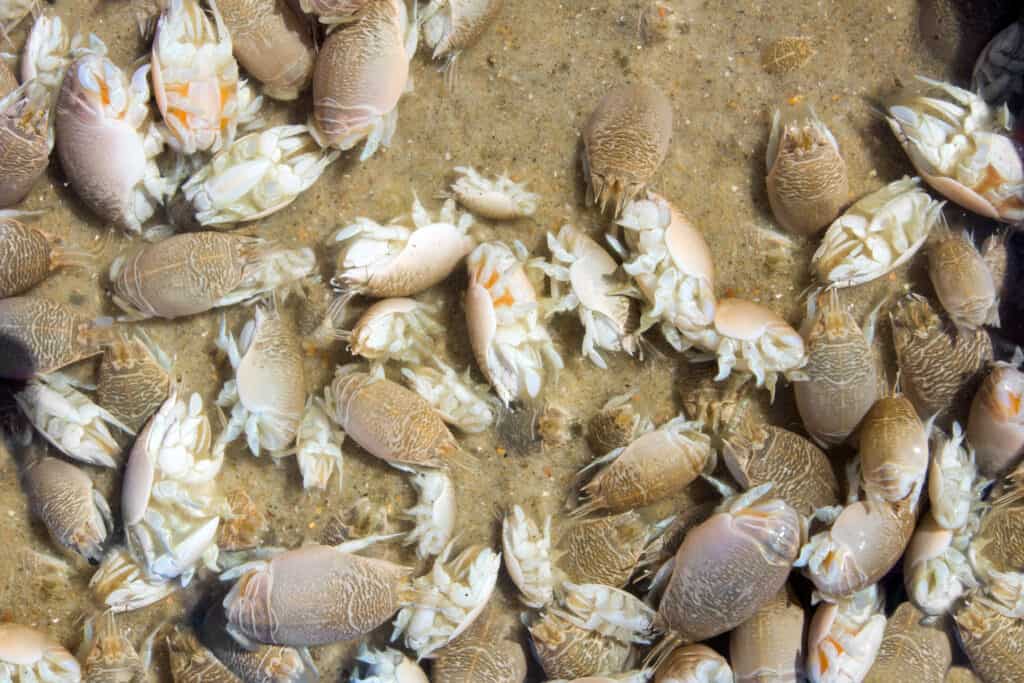
Sandfleas can quickly infest a home and bite pets and humans.
©IrinaK/Shutterstock.com
The most common sand flea is not an insect-like pet flea but a tiny crustacean. Another thing that separates the sandflea from the pet flea is that pet fleas live on animals and do not live on humans. But sandfleas will live on humans. The tiny, biting crustaceans also leave serious skin wounds when they feed, and pet fleas leave red welts.
A female sandflea can lay eggs under a human’s or host animal’s skin. These crustaceans are called sandfleas because they are found in sandy areas near beaches or other bodies of water. Having these fleas in your house makes you vulnerable to the diseases they carry and spread. Most people do not realize the crustaceans have moved into their homes until they see the evidence of bite marks on their ankles and feet.
Pet Fleas
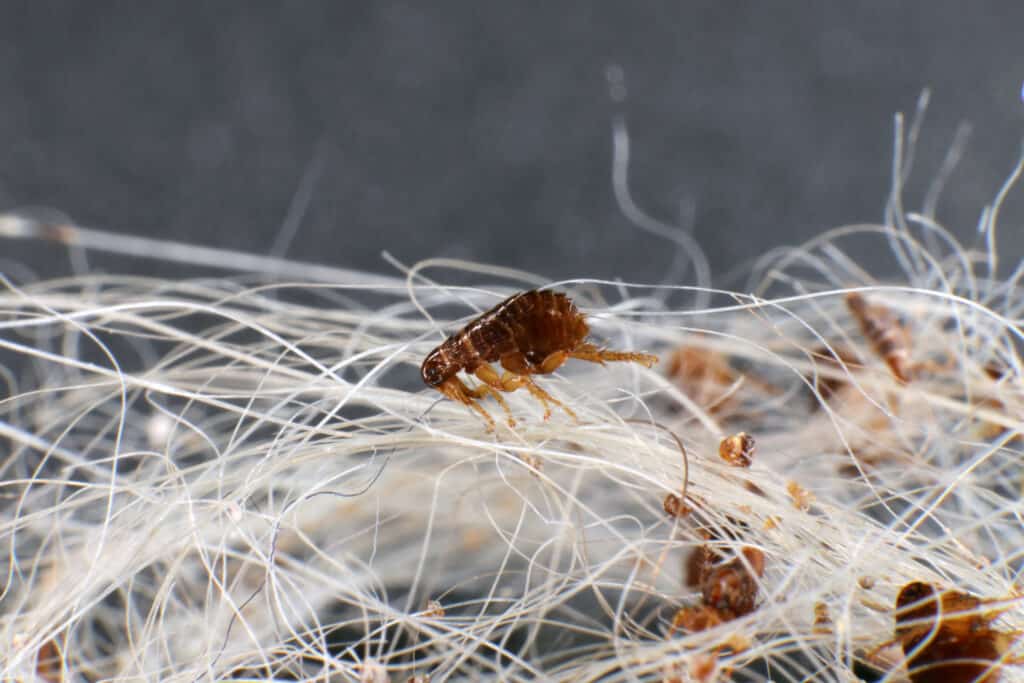
Pet fleas are buried in the hair of the host animal.
©photowind/Shutterstock.com
The fleas most commonly found on dogs and cats are pet fleas. This flea will bite humans and feed on their blood, but it does not make its home on human skin. Pet fleas are insects. Seven species of flea are found on pets, such as dogs and cats.
We see fleas as inconvenient and forget they carry and spread serious diseases. The bubonic plague is spread by fleas that bite an infected host and then bite you.
1. Unexplained Red Welts
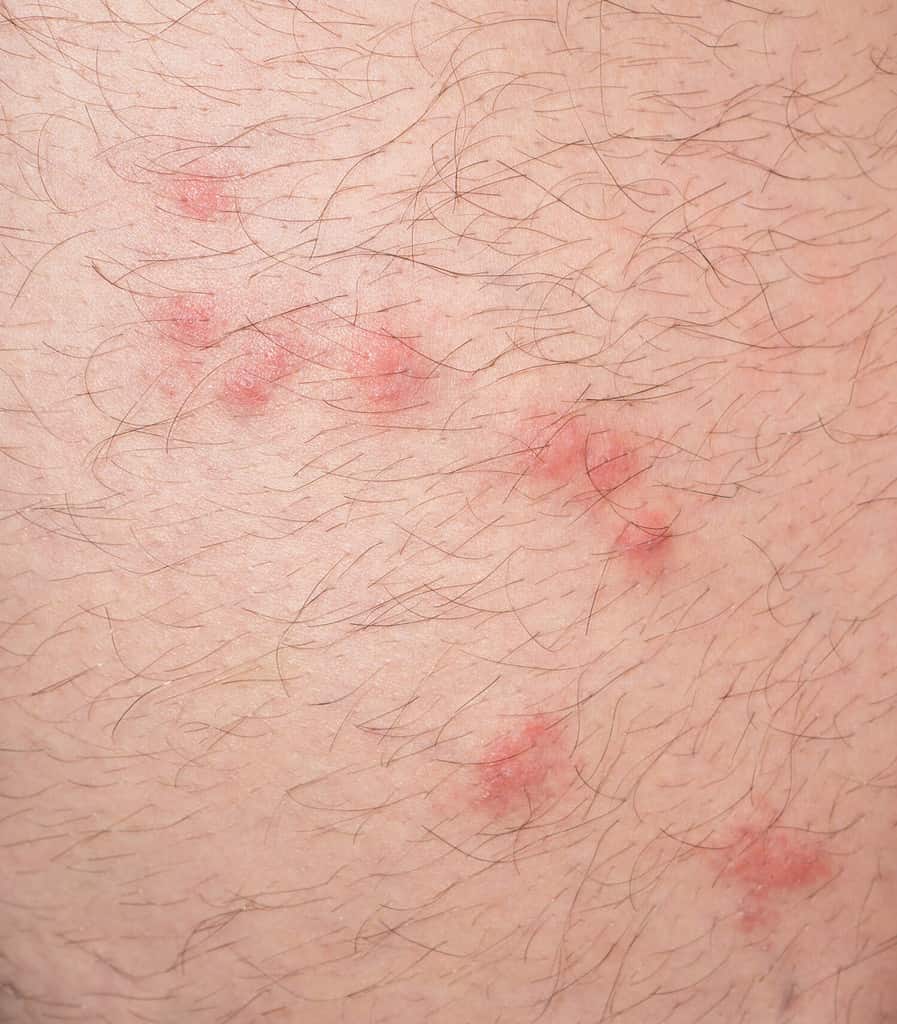
The bites from these insects leave red welts that itch.
©FCG/Shutterstock.com
Saliva from a flea bite is the cause of the raised red welts on human skin after they are bitten. The redness and itching are an allergic reaction to the insect’s saliva. If you have fleas in your house, you will notice red welts, itchy spots, or red skin on your ankles and lower extremities.
If you examine the raised welt made by a flea bite with a magnifying glass, you will notice a single puncture in the center of the bite. The severity of the itching will depend on the severity of your reaction to the insect bite.
2. Live Fleas on You
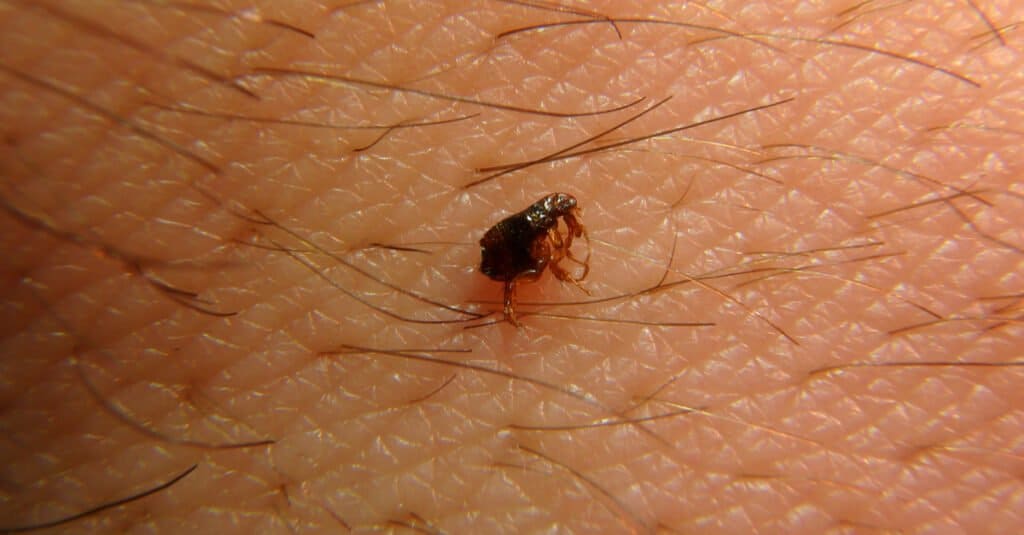
Finding one of the live insects on you indicates an infestation.
©David Jara Bogunya/Shutterstock.com
If fleas are in your house, you will see the insects on your body. They are very fast, and they can jump up to eight inches. If you see a flea while holding your pet, the insect may have jumped from your dog or cat onto you.
These insects also lay eggs on carpets and furniture around your home. When you see a live flea on your skin or clothing, an infestation is present in your home.
Do The White Sock Test
To be sure that there are many fleas in your house, you can perform the white sock test. Put on a pair of white socks and walk around your home. Fleas jump onto the socks, and the dark insect is easier to see on the white fabric of the socks.
If you see fleas on the socks, your home is infested with fleas. Treating your home for fleas will require you to treat the rooms, wait two weeks, and then treat them again. It can take several attempts before you get rid of these unwanted insects.
3. Flea Dirt In Carpets Or Around Baseboards
Finding flea dirt on your carpeting or in the nooks and crannies of your house is a sure sign that you have fleas and how severe the infestation is. Flea dirt is flea droppings or excrement left behind by insects.
You can identify flea dirt on your pet by taking a damp cloth and wiping the infected area. When you inspect the damp cloth and see flecks of dark matter or red smears, you have found flea dirt.
The flea dirt appears red because it is animal blood that the insect cannot digest and process.
4. Pets Scratching Excessively
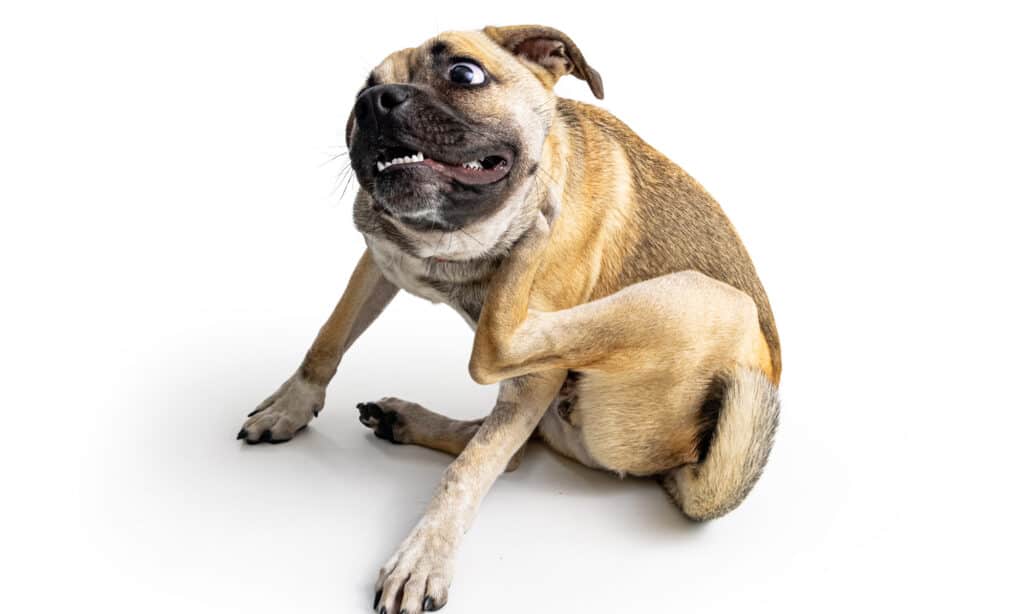
The fourth way to spot an infestation is by scratching excessively.
©iStock.com/adogslifephoto
When fleas move around on dogs, the sensation irritates the pet. They scratch to make the irritation go away. When fleas bite the animals, the animals scratch because they react to the flea’s saliva, and the bite itches. When you have fleas in your house in large numbers, your pets will scratch excessively because they will be constantly bombarded with insect attacks.
5. Dark Spots on Pets’ Fur

Dark spots or red smears on animal fur indicate insect presence.
© ThamKC/Shutterstock.com
The flea dirt you find in your nooks and crannies when you have fleas in your house will also be present on any pets living there. This dirt is excrement and a huge indicator that the insects are present, even if you cannot see them with your naked eye.
6. Finding Flea Eggs
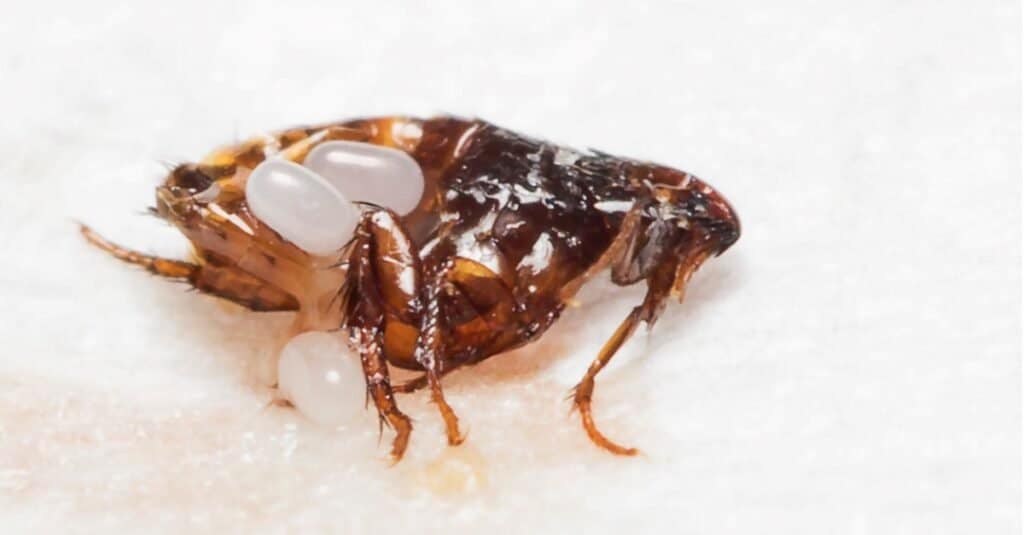
Eggs are miniature and clear, so they are challenging to find.
©iStock.com/FMT Fotografia
The fleas‘ eggs in your house will be the size of a grain of salt. Eggs can be found on your pet’s bedding, your furniture, your carpets, along the baseboards of the room, and in your bed. The eggs can hatch in one to ten days. When the eggs hatch,, they are flea larvae, and the larvae feed on blood and the excrement left by adult fleas.
Fleas in your house create a vicious cycle of newly hatching eggs, larvae in different stages of development, and adults. Getting rid of an infestation will take up to three months of regular application of flea preventative and treatment products.
7. Pets Have Pale Gums
Flea infestations can be discovered by checking the gums of your dogs and cats. If the animal has excessive flea exposure, the insects can cause the animal to suffer from anemia. Anemia is a reduction of the red blood cells caused by the insects biting the animal so frequently.
If your pet has pale gums, you should take the matter seriously. You will see the fleas on the animal and in your house before they cause anemia in your pet.
8. Pets Have an Unpleasant Musty Odor
Animals that have severe flea infestations have a musty body odor. The flea dirt, which is flea poop and old blood that the insect did not digest properly, is the leading cause of the odor. Another contributing factor to the musty odor is the animal’s skin reacting to the saliva of the fleas. An infection can establish on the skin of the dog,, and this results in a musty or foul odor.
9. Pets Are Losing Their Hair
When you have excessive fleas in your house, your pets will be constantly bitten by the insects. The animal will scratch at their fur to relieve the itch. Over time, the animal’s fur will fall out, leaving red and inflamed-looking skin. People often think their pet has the disease when it has an infestation or an allergic reaction to multiple flea bites.
Bathing the animals, treating them for fleas, and treating the animal’s bedding will resolve the problem, and the animal fur will grow back. To be sure that the hair loss is caused by fleas, take the animal to the vet for a diagnosis.
10. Pets Are Restless
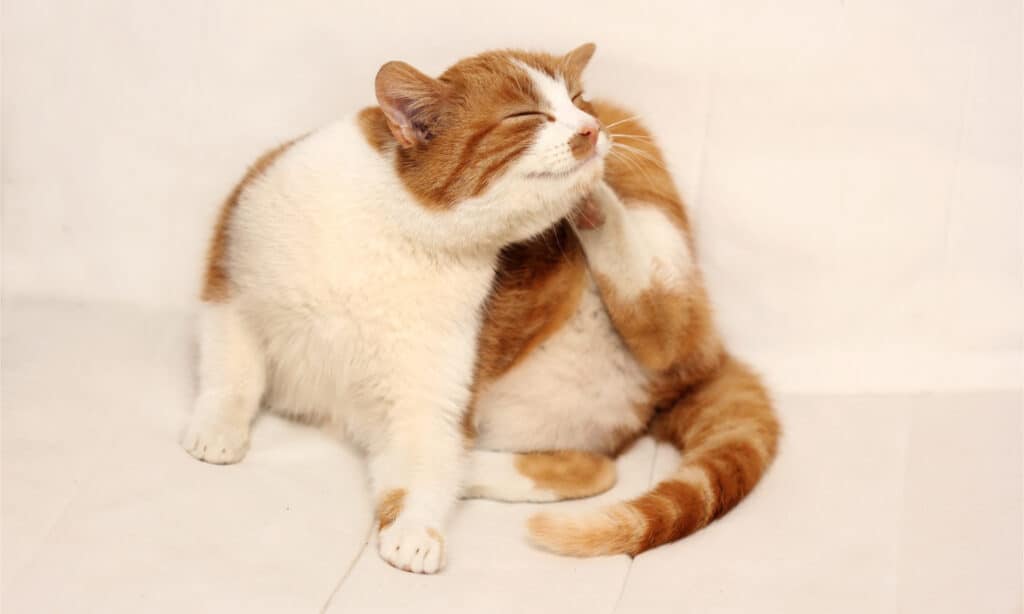
Restless animals don’t sleep well and scratch constantly.
©Natata/Shutterstock.com
If you have fleas in your house and on your pets,, the animals will not be comfortable or able to relax. They will move around more instead of lying down and sleeping and scratch. Restless animals become irritable and often bite at their skin, trying to make the irritation they feel go away.
Learn your animal’s normal behavior patterns, and when you see changes like restlessness, inspect their fur and ears for signs of fleas or flea dirt. Treat your animals regularly with preventive flea medications to give them relief and stop your house from becoming overrun with the tiny insects.
Summary Of Flea Infestation: 10 Ways To Tell How Bad It Really Is
| 1 | Unexplained Red Welts |
| 2 | Live Fleas on You |
| 3 | Flea Dirt In Carpets Or Around Baseboards |
| 4 | Pets Scratching Excessively |
| 5 | Dark Spots on Pets’ Fur |
| 6 | Finding Flea Eggs |
| 7 | Pets Have Pale Gums |
| 8 | Pets Have an Unpleasant Musty Odor |
| 9 | Pets Are Losing Their Hair |
| 10 | Pets Are Restless |
The photo featured at the top of this post is © kobkik/Shutterstock.com
Thank you for reading! Have some feedback for us? Contact the AZ Animals editorial team.







